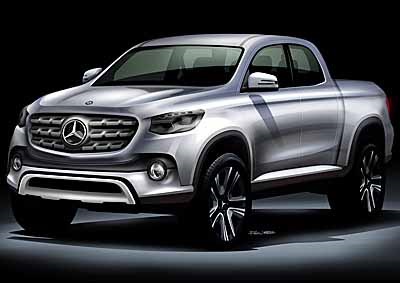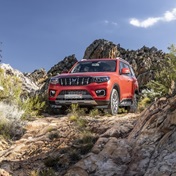
JOHANNESBURG, Gauteng - Mercedes-Benz has surprised the automotive world by announcing its intention to build “the first mid-sized pick-up from a premium manufacturer” before 2020.
It is of special interest to South Africa as this Benz bakkie is specifically aimed at our market, as well as Australia and some countries in Latin America and Europe.
The Stuttgart-based automaker indicated that it would enter this “promising segment with global scope” as it will “contribute nicely to our global growth targets”. An artist’s rendering of the proposed pickup was also released (see above).
THE FIRST PICK-UP
The statement reads: “Thanks to their versatility, all-round utility and metric-ton payload, pick-ups are popular across the world and thus have good sales potential.”
Dieter Zetsche, chairman of the management board of Daimler AG and head of Mercedes-Benz cars division, said: “We will enter this segment with our distinctive brand identity and the vehicle attributes typical of the brand with regard to safety, comfort, power trains, and value.”
South Africa should follow the development of this new pick-up with interest but actually Mercedes-Benz bakkies were already built over 60 years ago – also in South Africa.
OK, they did not receive specific model codes, but were built with the full blessing of Daimler-Benz AG and in a South African context the basic donor chassis was exported here solely for the purpose of a bakkie conversion.
Also, while many conversions of ’Benzes were done over the years, the SA conversions were the first and one of few with a sustained production run in the manufacturer’s long history.
The first “bakkie” with a Merc badge was converted from the W136 170V model. It was assembled in Germany from 1946-49; 1098 were built, mostly for government services.
This platform was also the basis for vehicles converted in Argentina and South Africa, with small numbers exported to Australia, New Zealand and the erstwhile South-West Africa (Namibia).
In Argentina the W136 170D was assembled in Mercedes-Benz’s San Martin facility from 1952-55, but it’s not clear how many pick-ups were produced.
BUILT IN SA - 60 YEARS AGO
In South Africa the idea of producing a pick-up, as described by the late Fred Schnetler in his book Progress, Passion and People, the Making of Daimler Chrysler South Africa, originated in the early 1950’s with the six original post-war independent Mercedes-Benz importers.
At that time Cargo Motors in Johannesburg, NMI in Durban, Stanley Porter in Cape Town, Haaks Garage in Pretoria, Ronnie's Motors in East London and John Williams Motors in Bloemfontein were all selling Mercedes and other German makes.
However, they were severely limited by the by the strict allocation of car import permits (for example, in 1955 they could only sell 100 cars) while bakkies, classified as commercial vehicles, were exempt from these strict regulations.
With the assistance of engineer Heinz Grossman and Mercedes-Benz’s central office in Johannesburg the importers concluded a deal with Daimler-Benz AG to, instead of fully built-up cars, import so-called “chassis-cabs” or "half-cars" –a built-up vehicle without the body section behind the B pillar.
PONTON 'HALF-CARS'
Initially some 170D/SD’s were imported in this fashion but it soon changed to the iconic W120 Mercedes 180D Ponton model.
The Ponton had a 1767cc OM636 VII diesel engine - the first diesel engine Mercedes produced after the war – with a piffling power output of 29kW at 3200rpm and 101Nm of torque at 2000rpm.
Getting approval from Stuttgart (Germany) for the 180D half-cars was one thing, finding a local coachbuilder capable of building a load box of the quality of the rest of the car was even more of a challenge.
Eventually, the company Morewear Industries in Germiston fabricated the load-box as desired and the result was convincing – quality- and design-wise.
The first Mercedes 180D Ponton bakkies went on sale in 1955. Besides being known as “bakkies”, they were also called “Stanley Porters” after the Cape Town Mercedes importer. While exact numbers are not known, about 400 were sold up to 1958.
Production ceased when Daimler-Benz, recognising the potential of the SA market, started local assembly of the 180 sedan in East London and thereby annulled the import quota restrictions.
GERMAN INTEREST
The bakkie’s success did not go unnoticed in Germany. Coachbuilder Binz used its close ties to Merc to, in 1956, start production of its own version of the pick-up.
There were some distinct differences between the local bakkie and the Binz, the most prominent being the gap between the cabin and load-box of the SA vehicle, while the Binz did not have it.
The original bakkie’s rear fenders were part of the load box (a neat solution) while the Binzes were unaltered, giving it a different look. Its tail lights were higher and the cabin was slightly longer to accommodate the spare tyre behind the left seat.
The Binz cabin was shorter and the spare was in a compartment under the tail.
It’s estimated that Binz produced around 450 pick-ups; some were exported to South Africa. According to Daimler-Benz files 2439 of the 180D were produced from 1955-62; 136 of the 190D body type were apparently also converted.
In total around 550 Benz 180D bakkies were on South African roads by the end of the 1950’s. Not many have survived; today they have great collectors value.
Interestingly, between 1971 and 1975 Mercedes-Benz in Argentina used a Santa Fe coachbuilder to convert W115 220D models to half-ton pickups on a Binz-based design.
NEWBIE WITHOUT A NAME
How will Mercedes-Benz Vans division, responsible for the V-Class and Vito, and now also for the new pick-up, identify its newbie? In terms of Mercedes’ latest naming convention the letters A, B, C, E, G, S and V are already allocated. The German word for pick-up is “Pritsche” so, if there is consistency in the manufacturer’s naming protocol, the new “pritschewagen” should be distinguished by the letter P.
Acknowledgements: These sources were used for this article:
Fred Schnetler: Progress, Passion and People, the Making of Daimler Chrysler South Africa, Daimlerchrysler South Africa, 2002
Blog by Bernd S Koehling: http://benz-books.com/blog/572/a-mercedes-180d-called-bakkie/
For additional reference, book by Bernd S Koehling: Mercedes-Benz, The 1950s, Volume 2: W120, W121, W180, W128, W198
Website: http://www.mbzponton.org/
Document by Gary George Bowes: http://bit.ly/1Hh2xKh
Website: http://www.autohistoria.com.ar/Historias/Mercedes_Benz.htm
Pictures and illustrations courtesy of Gary Bowes, SA, Binz Karosseriebau and Daimler AG




 Publications
Publications
 Partners
Partners











